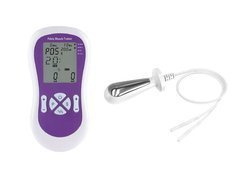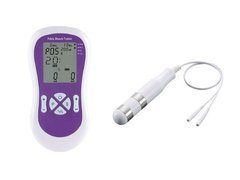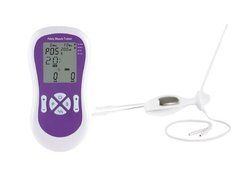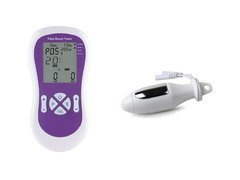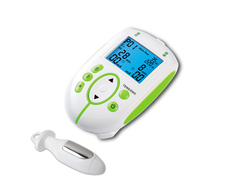Electrostimulators for the pelvic floor muscles
( number of products: 9 )Pelvic floor muscle stimulators are medical devices that can be used after childbirth to strengthen the pelvic floor muscles. Pelvic floor muscle weakness can occur after childbirth, which can lead to urinary incontinence, pelvic organ prolapse, and other discomforts. Kegel muscle stimulators work by sending electrical impulses to the muscles, helping to strengthen them and restore their normal function.
Electrostimulators for the Pelvic Floor Muscles After Birth
After childbirth, the pelvic floor muscles often lose their natural strength and elasticity due to stretching, hormonal changes, and increased pressure during pregnancy and delivery. This can result in symptoms such as urinary incontinence, a feeling of pelvic heaviness, or reduced muscle control. Recovery of these muscles is essential for restoring physical comfort, confidence, and long-term pelvic health.
What Is Electrostimulation Therapy?
Electrostimulation therapy offers an effective, safe, and clinically supported way to rebuild pelvic floor strength after birth. Using mild electrical impulses delivered via a vaginal probe or external electrodes, an electrostimulator activates and contracts the pelvic muscles. This gentle stimulation reawakens neuromuscular connections and promotes healthy blood circulation, which supports tissue healing and recovery.
Device Types and How They Are Used
Electrostimulators for postpartum use are medical-grade devices designed specifically for women recovering from childbirth. They can be used with a vaginal probe or an external electrode depending on comfort and stage of recovery. Most units include personalized programs that gradually increase intensity to match the user’s progress. Typical sessions are brief and scheduled regularly to encourage progressive strengthening without overexertion.
Key Benefits of Postpartum Electrostimulation
One of the main advantages of electrostimulation after childbirth is targeted training even when voluntary contractions are difficult. Many new mothers struggle to perform Kegel exercises effectively because of reduced muscle awareness. With electrostimulation, the device initiates muscle contractions automatically, helping to retrain the body and strengthen the pelvic floor efficiently. Regular use improves muscle control, enhances bladder stability, and restores confidence in daily activities.
Conditions Commonly Helped by Electrostimulation
• Stress urinary incontinence (leakage during coughing, sneezing, or exercise)
• Pelvic floor weakness or muscle fatigue
• Postpartum pelvic pain or tension
• Reduced sexual sensitivity or muscle tone
When to Start and Medical Guidance
Electrostimulation is typically introduced six to eight weeks after delivery, once healing is complete and a healthcare professional has approved its use. Timing can vary by individual circumstance—recovery after cesarean section or complicated deliveries may require different guidance—so clinical clearance is important. Electrostimulation may also be combined safely with biofeedback tools (for example, the Emy probe) to track progress and improve voluntary muscle coordination.
Practical Aspects: Safety, Comfort, and Home Use
Modern electrostimulators are compact, easy to operate, and suitable for supervised home therapy. They include preset programs for strengthening, relaxation, and recovery, allowing each woman to adapt therapy to her needs. Probes and electrodes are manufactured from body-safe materials and cleaned according to the manufacturer’s instructions. With consistent, correct use, many users notice a gradual reduction in leakage, better muscle control, and improved core stability.
Integrating Electrostimulation into a Postpartum Recovery Plan
Electrostimulation works best as part of a holistic rehabilitation approach that includes guided pelvic floor exercises, posture and breathing training, gradual reintroduction of physical activity, and, when appropriate, professional physiotherapy. This combined strategy helps restore both muscular strength and neuromuscular control, reducing the risk of long-term complications and supporting a faster, more comfortable recovery.
Psychological and Functional Benefits
Beyond physical recovery, regaining pelvic floor function supports mental well-being. Restored continence and bodily control reduce anxiety about leakage, improve freedom of movement, and enhance intimacy and self-confidence. Many new mothers report that successful pelvic rehabilitation positively affects daily life, caregiving activities, and return to sport or exercise.
Choosing a Device and Seeking Professional Support
When selecting an electrostimulator, prioritize CE-marked medical devices from reputable manufacturers, look for clear user guidance and adjustable programs, and consider devices compatible with biofeedback if you wish to track progress. Always consult a midwife, pelvic physiotherapist, or physician before beginning therapy to confirm appropriateness and receive individualized instructions.
Summary
Electrostimulation for the pelvic floor after childbirth is an evidence-based, non-invasive method to accelerate muscle recovery, reduce urinary symptoms, and rebuild confidence. Used correctly and under professional guidance, electrostimulation helps women re-establish pelvic tone, improve bladder stability, and support long-term pelvic health. PelviCare’s selection of postpartum electrostimulation devices is chosen for safety, clinical effectiveness, and user-friendly operation to help new mothers reclaim strength and balance after birth.

